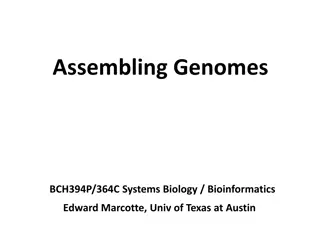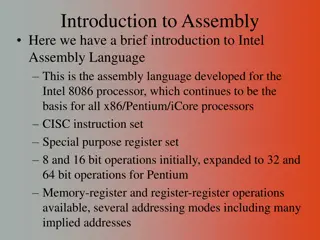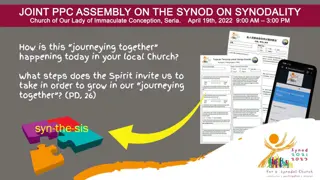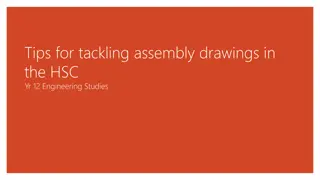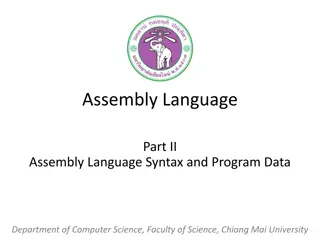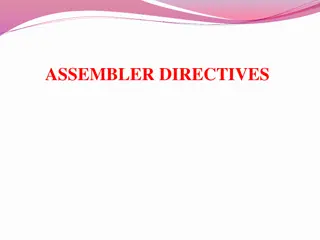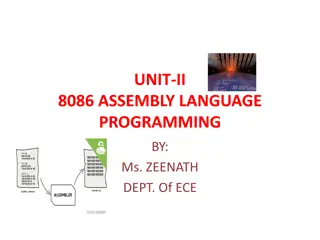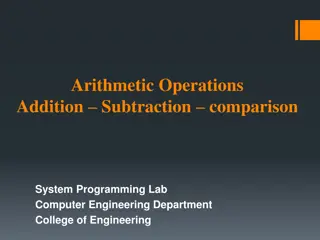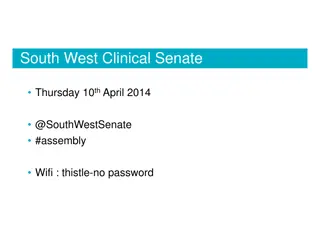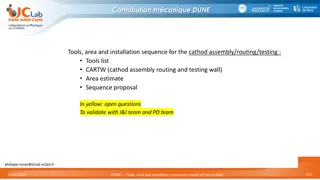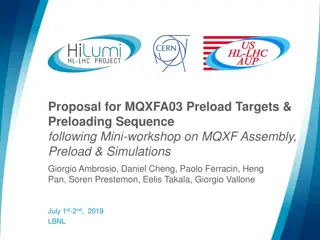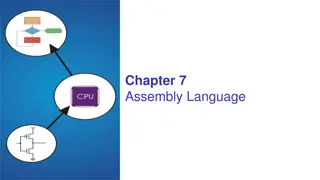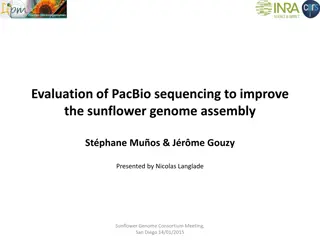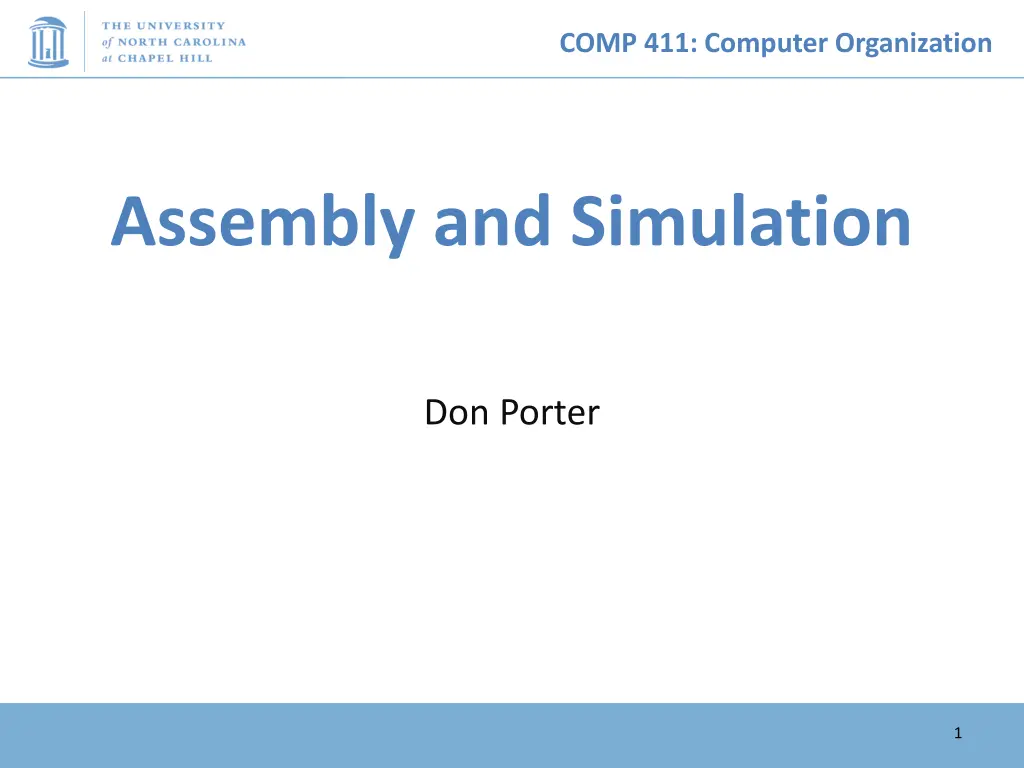
Understanding Computer Organization and Assembly Programming
Explore the fundamentals of computer organization and assembly programming, including topics such as what an assembler is, the structure of assembly programs, defining assembler directives, and the syntax of assembly language. Dive into MIPS assembly programming using the MARS development environment with coding examples for self-study. Gain insights into the assembly source language, assembler directives control, and syntax, along with practical knowledge on writing and translating programs in machine language.
Download Presentation

Please find below an Image/Link to download the presentation.
The content on the website is provided AS IS for your information and personal use only. It may not be sold, licensed, or shared on other websites without obtaining consent from the author. If you encounter any issues during the download, it is possible that the publisher has removed the file from their server.
You are allowed to download the files provided on this website for personal or commercial use, subject to the condition that they are used lawfully. All files are the property of their respective owners.
The content on the website is provided AS IS for your information and personal use only. It may not be sold, licensed, or shared on other websites without obtaining consent from the author.
E N D
Presentation Transcript
COMP 411: Computer Organization Assembly and Simulation Don Porter 1
COMP 411: Computer Organization Today Assembly programming structure of an assembly program assembler directives data and text segments allocating space for data MIPS assembler: MARS development environment A few coding examples self-study
COMP 411: Computer Organization What is an Assembler? A program for writing programs Machine Language: 1 s and 0 s loaded into memory. (Did anybody ever really do that?) Assembly Language: ASM main: subu $sp, $sp, 24 sw $ra, 16($sp) li $a0, 18 li $a1, 12 li $a2, 6 jal tak move $a0, $v0 Front panel of a classic PDP8e. The toggle switches were used to enter machine language. STREAM of bits to be loaded into memory 01101101 11000110 00101111 10110001 ..... .globl main Symbolic SOURCE text file ASSEMBLER Translator program Binary Machine Language Assembly: A Symbolic LANGUAGE for representing strings of bits Assembler: A PROGRAM for translating Assembly Source to binary
COMP 411: Computer Organization Assembly Source Language An Assembly SOURCE FILE contains, in symbolic text, values of successive bytes to be loaded into memory... e.g. .data 0x00000000 .byte 1, 2, 3, 4 .byte 5, 6, 7, 8 .word 1, 2, 3, 4 .asciiz "Comp 411" .align 2 .word 0xfeedbeef .text 0x00003000 Specifies address for start of program text Specifies address for start of data below Four byte values Another four byte values Four word values (each is 4 bytes) A zero (NULL) terminated ASCII string Align to next multiple of 22 A hex-encoded word value Resulting memory dump: [0x00000000] 0x04030201 0x08070605 0x00000001 0x00000002 [0x00000010] 0x00000003 0x00000004 0x706d6f43 0x31313420 [0x00000020] 0x00000000 0xfeedbeef 0x00000000 0x00000000 Notice the byte ordering. This MIPS is little-endian (The least significant byte of a word or half-word has the lowest address)
COMP 411: Computer Organization Assembler Syntax Assembler DIRECTIVES = Keywords prefixed with . Control the placement and interpretation of bytes in memory .data <addr> Subsequent items are considered data .text <addr> Subsequent items are considered instructions .align N Skip to next address multiple of 2N Allocate Storage .byte b1, b2, , bn Store a sequence of bytes (8-bits) .half h1, h2, , hn Store a sequence of half-words (16-bits) .word w1, w2, , wn Store a sequence of words (32-bits) .ascii string Stores a sequence of ASCII encoded bytes .asciiz string Stores a zero-terminated string .space n Allocates n successive bytes Define scope .globl sym Declares symbol to be visible to other files .extern sym size Sets size of symbol defined in another file (Also makes it directly addressable)
COMP 411: Computer Organization More Assembler Syntax Assembler COMMENTS All text following a # (sharp) to the end of the line is ignored Assembler LABELS Labels are symbols that represent memory addresses labels take on the values of the address where they are declared labels can be for data as well as for instructions Syntax: <start_of_line><label><colon> .data 0x80000000 item: .word 1 # specifies where data starts # a data word int item=1; .text 0x00010000 start: add sll andi beq # specifies where code text starts # an instruction label $3, $4, $2 $3, $3, 8 $3, $3, 0xff ..., ..., start
COMP 411: Computer Organization Even More Assembler Syntax Assembler PREDEFINED SYMBOLS Register names and aliases $0-$31, $zero, $v0-$v1, $a0-$a3, $t0-$t9, $s0-$s7, $at, $k0-$k1, $gp, $sp, $fp, $ra Assembler MNEMONICS Symbolic representations of individual instructions add, addu, addi, addiu, sub, subu, and, andi, or, ori, xor, xori, nor, lui, sll, sllv, sra, srav, srl, srlv, div, divu, mult, multu, mfhi, mflo, mthi, mtlo, slt, sltu, slti, sltiu, beq, bgez, bgezal, bgtz, blez, bltzal, bltz, bne, j, jal, jalr, jr, lb, lbu, lh, lhu, lw, lwl, lwr, sb, sh, sw, swl, swr, rfe not all implemented in all MIPS versions Pseudo-instructions (mnemonics that are not instructions) abs, mul, mulo, mulou, neg, negu, not, rem, remu, rol, ror, li, seq, sge, sgeu, sgt, sgtu, sle, sleu, sne, b, beqz, bge, bgeu, bgt, bgtu, ble, bleu, blt, bltu, bnez, la, ld, ulh, ulhu, ulw, sd, ush, usw, move,syscall, break, nop not real MIPS instructions; broken down by assembler into real ones
COMP 411: Computer Organization MARS Settings For some of the examples, following Settings apply: (unless specified otherwise) Permit extended (pseudo) instructions and formats is enabled allows pseudoinstructions to be used allows variable names to be used (instead of just their addresses) Memory Configuration is set to "Compact, Data at Address 0 many of our examples assume that data starts at address 0, and program code starts at address 0x3000
COMP 411: Computer Organization A Simple Programming Task Add the numbers 0 to 4 0 + 1 + 2 + 3 + 4 sum is 10 Program in C : int i, sum; main() { sum = 0; for (i=0; i<5; i++) sum = sum + i; } Now let s code it in ASSEMBLY
COMP 411: Computer Organization Assembly Code: Sum.asm Simple version: put all variables in registers Start addr of text is optional A convention borrowed from the C language: the entry point of a program is named main . .text 0x3000 main: add $8,$0,$0 # sum = 0 add $9,$0,$0 # for (i = 0; ... loop: add $8,$8,$9 # sum = sum + i; addi $9,$9,1 # for (...; ...; i++ slti $10,$9,5 # for (...; i<5; bne $10,$0,loop # is $10 true? ie, != 0 end: ... Bookkeeping: 1) Register $8 is allocated as the sum variable 2) Register $9 is allocated as the i variable We will talk about how to exit a program later $8 will have sum $9 will have i # need something here to stop!
COMP 411: Computer Organization MARS MIPS Assembler and Runtime Simulator (MARS) Java application Runs on all platforms Links on class website Download it now!
COMP 411: Computer Organization A Slightly More Challenging Program Add 5 numbers from a list sum = n0 + n1 + n2 + n3 + n4 In C : int sum, i; int a[5] = {7,8,9,10,8}; main() { sum = 0; for (i=0; i<5; i++) sum = sum + a[i]; } Once more let s code it in assembly
COMP 411: Computer Organization Variable Allocation Let s put variables in memory locations rather than registers This time we add the contents of an array .data 0x0 sum: .space 4 i: .space 4 a: .word 7,8,9,10,8 Arrays have to be in memory. Why? Start addr of data is optional Note: .word also works for an array of words allows us to initialize a list of sequential words in memory label represents the address of the first word in the list, or the name of the array does this remind you of how C treats arrays as pointers?! Note: .space 4 means 4 bytes uninitialized .word needs initial value
COMP 411: Computer Organization The New Code: SumArray.asm Note the small changes: .text 0x3000 main: sw $0,sum($0) # sum = 0; sw $0,i($0) # for (i = 0; lw $9,i($0) # bring i into $9 lw $8,sum($0) # bring sum into $8 loop: sll $10,$9,2 # convert "i" to word offset lw $10,a($10) # load a[i] add $8,$8,$10 # sum = sum + a[i]; sw $8,sum($0) # update sum in memory addi $9,$9,1 # for (...; ...; i++ sw $9,i($0) # update i in memory slti $10,$9,5 # for (...; i<5; bne $10,$0,loop end: ... # code for exit here Assembler replaces sum with 0x0, i with 0x4, and a with 0x8 (see previous slide).
COMP 411: Computer Organization A couple of shortcuts Can skip the immediate or register field of lw/sw assumed to be zero lw $8,sum ... is the same as lw $8,sum($0) lw $8,($10) ... is the same as lw $8,0($10) assembler will fill in for you Also, can optimize code by eliminating intermediate updates in memory (next slide)
COMP 411: Computer Organization A couple of shortcuts Also, can optimize code by eliminating intermediate updates in memory a good C compiler will do that automatically for you main: add $9,$0,$0 # i in $9 = 0 add $8,$0,$0 # sum in $8 = 0 loop: sll $10,$9,2 # convert "i" to word offset lw $10,a($10) # load a[i] add $8,$8,$10 # sum = sum + a[i]; addi $9,$9,1 # for (...; ...; i++ slti $10,$9,5 # for (...; i<5; bne $10,$0,loop sw $8,sum($0) # update final sum in memory sw $9,i($0) # update final i in memory end: ... # code for exit here
COMP 411: Computer Organization A Coding Challenge What is the largest Fibonacci number less than 100? Fibonacci numbers: Fi+1 = Fi + Fi-1 F0 = 0 F1 = 1 0, 1, 1, 2, 3, 5, 8, 13, 21, 34, In C : int x, y; main() { x = 0; y = 1; while (y < 100) { int t = x; x = y; y = t + y; } }
COMP 411: Computer Organization MIPS Assembly Code: Fibonacci.asm In assembly let s use these registers: x $8 y $9 t $10 lw $8,x while: # while (y < 100) { slti $10,$9,100 beq $10,$0,endw add $10,$0,$8 # int t = x; add $8,$0,$9 # x = y; add $9,$10,$9 # y = t + y; j while # } endw: sw $8,x # answer is in x sw $9,y ... # code for exit here .data x: .space 4 # int x, y; y: .space 4 .text main: sw $0,x # x = 0; addi $9,$0,1 # y = 1; sw $9,y
COMP 411: Computer Organization Coming Up Parameterized Programs Procedures Stacks MIPS procedure linkage conventions



